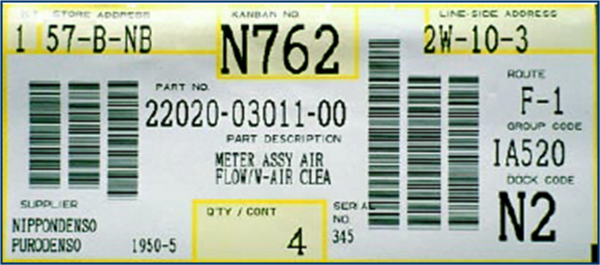Kanban is a system that supports level production by helping maintain stable supply and efficient operations. The question of how many kanban are needed is at the core of designing and running a kanban system. If your business process performs mostly standard, repeated operations the number of kanban can be calculated as follows:
Number of kanban = (Daily Demand * (Replenishment Time + Safety Margin))/Standard Container Quantity
- Daily Demand = monthly orders / work days in the month;
(Can use historical actual orders if demand is stable, may need to use current booked orders or forecast) - Replenishment Time = sum of all the processing, transportation, handling, and queue times from freshly empty container to full container back to empty again
- Safety Margin = either a statistical calculation to accommodate variation in demand and/or supply, or an intuition to add zero to a few extra days
(Regardless of which approach you pick, once up and running begin removing kanban one at a time until you’ve gone too far, then add one back and spend some time to figure out the cause – i.e. lower the water level and expose a few rocks.) - Standard Container Quantity is where we often have the greatest latitude. We usually can’t change the daily demand. Speeding up the replenishment time takes time. Selecting the right size container we can do right now. Sometimes we’ll turn the equation around and instead of solving for the number of kanban we’ll pick the number of kanban and then determine the right container size, like so …
Standard Container Quantity = (Daily Demand * (Replenishment Time + Safety Margin))/Number of Kanban
Rule of thumb: try to keep the number of kanban between 2 and 10 by adjusting the size of the kanban container.

4 thoughts on “How many kanban do you need?”
The formula we normally use is:
Number of Kanban = Daily Demand * Lead Time * (1 + Safety Stock) / Container Quantity
You can try some example en exercise to solve on http://www.leanlab.name
http://www.leanlab.name/kanban-calculation-a4-solved-exercises
Sean, try
– Shigeo Shingo, Study of ‘Toyota’ Production System (Japanese Management Association, 1981)
– Raymond S. Louis, Integrating Kanban with MRPII (Productivity Press, 1997)
– Rick Harris, Chris Harris, and Earl Wilson, Making Materials Flow (The Lean Enterprise Institute, 2003)
– Kanban for the shopfloor (Productiity Press, 2002)
Also search this site for examples and other postings on kanban.
Lawrence,
Do you have a reference book that shows some examples of using this equation and some testing to get a line up and running?
– Sean